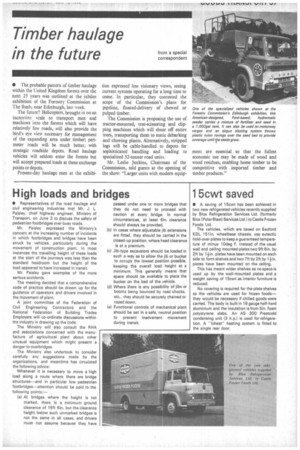High loads and bridges
Page 39

If you've noticed an error in this article please click here to report it so we can fix it.
• Representatives of the road haulage and civil engineering industries met Mr. J. L. Paisley, chief highway engineer. Ministry of Transport, on June 3 to discuss the safety of pedestrian footbridges over busy roads.
Mr. Paisley expressed the Ministry's concern at the increasing number of incidents in which footbridges and bridges have been struck by vehicles, particularly during the movement of construction plant. In most instances the travelling height of these loads at the start of the journeys was less than the standard headroom but the height of the load appeared to have increased in transit.
Mr. Paisley gave examples of the more serious accidents.
The meeting decided that a comprehensive code of practice should be drawn up for the guidance of operators and drivers involved in the movement of plant.
A joint committee of the Federation of Civil Engineering Contractors and the National Federation of Building Trades Employers will co-ordinate discussions within the industry in drawing up the code, The Ministry will also consult the RHA and associations concerned with the manufacture of agricultural plant about other unusual equipment which might present a danger to overbridges.
The Ministry also undertook to consider carefully any suggestions made by the organizations, and meantime has circulated the following advice: Whenever it is necessary to move a high load along a route where there are bridge structures—and in particular low pedestrian footbridges--attention should be paid to the following poi nts:— (a) At bridges where the height is not marked, there is a minimum ground clearance of 16ft 6in. but the clearance height below such unmarked bridges is not the same in all cases, and drivers must not assume because they have passed under one or more bridges that they do not need to proceed with caution at every bridge. In normal circumstances, at least 6in. clearance should always be provided.
(b) In cases where adjustable jib extensions are fitted, they should be carried in the closed-up position, where head clearance is at a premium.
(c) Jib-type excavators should be loaded in such a way as to allow the jib or bucket to occupy the lowest position possible, keeping the overall load height at a minimum. This generally means that space should be available to place the bucket on the bed of the vehicle.
(d) Where there is any possibility of jibs or booms being bounced by road shocks, etc., they should be securely chained or roped down.
(e) Functional controls of mechanical plant should be set in a safe, neutral position to prevent inadvertent movement during transit.
























































































































































